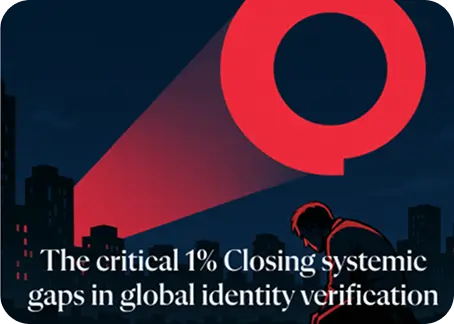Anti-Money Laundering (AML) Screening

Money laundering remains one of the most pervasive financial crimes in the world. According to recent estimates by the United Nations Office on Drugs and Crime (UNODC), between $800 billion and $2 trillion — 2-5% of global GDP — is laundered annually.
Governments, financial institutes, and businesses are all under increased pressure to find ways to combat money laundering and financial crimes using advanced AML screening and regulatory compliance. As criminals adapt their tactics using evolving technologies, AML strategies must also adapt to stay ahead.
What is Money Laundering?
Money laundering is the process by which illicit funds are disguised to make them appear legitimate. It is often used by drug traffickers, terrorist organizations, corrupt officials, and financial criminals with the intent of making it difficult for authorities to trace the origin of the money. These tactics can include using shell companies, structuring transactions just below reporting levels, leveraging digital assets (e.g. cryptocurrencies), and exploiting institutions with weak anti-money laundering systems.
The money laundering process typically consists of three key stages, each designed to make detection more difficult:
- Placement: the initial introduction of illicit funds into the financial system in ways that are less regulated or likely to raise suspicion.
- These methods include: smurfing, structuring, cash-intensive businesses, and cryptocurrency exchanges
- Layering: using multiple transactions to obscure the audit trail, making it difficult to trace the origin of the illicit funds.
- Common techniques include: multiple cross-regional wire transfers, purchasing high-value assets, and using money mules
- Integration: the reintroduction of illicit funds into the legitimate economy, allowing that money to be spent without attracting suspicion from authorities.
- This can be through: investing in stocks/bonds/real estate, setting up offshore trusts, or creating fictitious jobs to justify income
Emerging technologies in digital finance, blockchain, and decentralized platforms have made money laundering more sophisticated and harder to detect. Cryptocurrencies like Monero and Zcash offer enhanced anonymity, DeFi platforms allow transactions without intermediaries, and NFTs value can be artificially inflated, making them all attractive for illicit activities. All of these have evolved in the past few years, making anti-money laundering checks and advanced compliance technologies more important than ever.
What is Anti-Money Laundering (AML)?
Anti-Money Laundering (AML) refers to the laws, regulations, and policies designed to detect, prevent, and report financial crimes. These measures protect banks and other financial institutions from exploitation in money laundering, corruption, fraud, terrorist financing, and other illicit activities.
Anti-money laundering compliance is enforced by governments and financial institutions worldwide in order to identify suspicious activities, monitor transactions, and hold businesses accountable for non-compliance.
Key AML Regulatory Bodies & Frameworks
- Financial Action Task Force (FATF)
-
-
- The leading global authority on AML, establishes international AML/CFT (Counter Financing of Terrorism) standards. It monitors member countries to ensure they are implementing effective policies to combat financial crime.
-
- U.S. Financial Crimes Enforcement Network (FinCEN)
-
-
- The largest AML watchdog in the U.S., oversees AML compliance in financial institutions, cryptocurrency exchanges, and high-risk businesses. It enforces key initiatives such as the Bank Secrecy Act (BSA), Corporate Transparency Act, and AML Act of 2020.
-
- EU’s 6th Anti-Money Laundering Directive (6AMLD)
-
-
- First implemented in 2020, 6AMLD introduces harsher penalties for violating AML laws, expanded criminal liability beyond financial institutions, and enhanced cross-border enforcement between member states.
- The EU is currently working toward creating the EU Anti-Money Laundering Authority (AMLA) — a central AML investigation and enforcement agency expected to begin operations in 2025.
- First implemented in 2020, 6AMLD introduces harsher penalties for violating AML laws, expanded criminal liability beyond financial institutions, and enhanced cross-border enforcement between member states.
-
- UK’s Economic Crime and Corporate Transparency Act (ECCTA)
-
-
- Passed in 2023, ECCTA works to strengthen ultimate beneficial ownership (UBO) transparency, combat shell company misuse, and increase AML enforcement measures as well as AML penalties.
-
- Asia-Pacific Anti-Money Laundering Regulations
-
- While there is no AML regulatory alliance in Asia-Pacific countries, key financial hubs in the region such as Singapore, Hong Kong, Australia, and Japan are all tightening their AML enforcement.
- Monetary Authority of Singapore (MAS) — requires financial institutions to conduct risk based AML screening and enhanced due diligence (EDD) for high-risk clients.
- Hong Kong’s Anti-Money Laundering Ordinance (AMLO) — Regulates AML compliance for banks, securities firms, and virtual asset service providers.
- Australia’s AUSTRAC Oversight — expands AML policy obligations to include casinos, gaming operators, and fintech companies.
- While there is no AML regulatory alliance in Asia-Pacific countries, key financial hubs in the region such as Singapore, Hong Kong, Australia, and Japan are all tightening their AML enforcement.
Failure to comply with AML regulations around the world can result in: significant fines, legal penalties, reputational damage, and loss of banking relationships. To avoid these risks, businesses must implement their own AML compliance programs to safeguard their operations and maintain customer trust.
What is AML Screening?
AML screening is a critical risk management process that helps businesses detect and prevent financial crimes. It involves assessing the risk level of an individual or an entity by checking them against sanctions lists, global watchlists, Politically Exposed Persons (PEP) databases, and adverse media reports.
With the growing complexity of financial crimes, regulatory requirements, and digital transactions, AML checks have become a mandatory compliance measure for companies ranging from financial institutions, to fintech companies, to high-risk industries such as gaming, real estate, and e-commerce.
Key Purposes of AML Screening
AML screenings serve multiple purposes to protect businesses and ensure compliance with global regulations.
- Risk Assessment — Identifies individuals and entities with known histories of financial crimes
- Sanctions Compliance — Ensure businesses don’t engage with entities that are banned or sanctioned by organizations like OFAC (U.S.), the EU, or the UN.
- Regulatory Protection — Helps businesses avoid penalties for non-compliance.
- Fraud Prevention — Detects synthetic identities, fake documents, and shell companies used to facilitate financial crimes.
- Enhanced Due Diligence — Provides additional scrutiny for high-risk individuals or groups, such as PEPs, high-net-worth-individuals (HNWIs), and businesses operating in high-risk sectors
By leveraging advanced AML screening tools, businesses can improve operational efficiency while adhering to regulatory standards.
When Should Businesses Perform AML Screening?
To ensure ongoing risk monitoring, AML screening is required during multiple stages of a customer or business relationship:
- During Account Opening — Conducted as part of Know Your Customer (KYC) verification before onboarding new customers.
- Ongoing Monitoring — Continuous monitoring is necessary to detect new sanctions, criminal activity, or adverse media associated with current clients.
- Employment Process — Background checks must be conducted on employees entering high-risk roles, particularly in finance, regulatory, and law enforcement sectors.
- UBO Screening — Ownership structures must be identified to detect hidden ownership by high-risk individuals or entities.
- Third-Party & Vendor Due Diligence — Organizations must ensure that they do not work with those involved in financial crime or sanction violations.
AML screening is a dynamic and ongoing process that requires regular updating and continuous monitoring to stay ahead of evolving financial crime tactics.
How is AML Screening Performed?
To ensure regulatory compliance, businesses must implement these procedures in their AML screening process:
- Collect Customer Information — Full name, date of birth, nationality & residential address, government-issued identification, employment & business information, source of funds & source of wealth.
- Data integrity is critical at this stage to avoid false positives, compliance failures, and fraud risks
- Checking Against AML Databases — Sanctions lists, PEP databases, adverse media reports, and law enforcement records.
- By automating these database checks, businesses reduce manual labor and increase the accuracy of risk detection.
- Apply Risk-Based Analysis — Asks questions such as: is the client a high-net-worth individual, do they come from a country with weak AML enforcement, are they making high-value transactions, and are they operating in high-risk sectors?
- Based on this assessment, clients are classified as low, medium, or high-risk, ensuring that clients of each category receive the most appropriate screening.
- Continuous Monitoring & Suspicious Activity Detection — Real-time alerts on transactions that deviate from the customer’s typical behavior, cross-border transactions (especially involving sanctioned countries), and unusual cash transactions.
- When suspicious activity is detected, businesses must file a Suspicious Activity Report (SARs) with regulatory authorities.
As financial crimes become more sophisticated, manual AML compliance solutions have become more and more ineffective. The future of AML screenings lies in developing AI systems that are capable of detecting fraud as it happens.
AML Screening: Key Trends & Innovations
As the AML compliance landscape evolves, businesses and financial institutions must utilize cutting-edge technologies to enhance risk detection, fraud prevention, and compliance efficiency. These emerging trends and innovations are set to redefine AML screening and financial crime prevention in the coming years:
- AI & Machine Learning for AML — analyzes massive datasets to identify suspicious patterns before financial crime occurs, improves detection accuracy to reduce false positives, automates case management which reduces manual compliance workloads.
- Behavioral Biometrics for Fraud Detection — uses dynamic user behaviors such as typing speed, keystroke dynamics, mouse movements, login habits, and session duration instead of just static identity data to continuously authenticate users.
- Decentralized Identity Verification & Blockchain for AML — utilizes blockchain-based KYC solutions to decentralize identity information which reduces the risk of forgeries and data breaches and allows for AML regulations to be enforced before transactions execute.
- Federated Learning for AML — allows institutions to collaborate without directly sharing sensitive data to maintain compliance with data privacy laws.
- Quantum-Safe Encryption — protects sensitive AML records against potential cyberattacks that use quantum computing which can ensure compliance longevity as the dangers of quantum decryption becomes more clear.
Businesses that embrace innovation in AML screening will be best positioned to navigate future compliance challenges while protecting their financial ecosystem.
AML Compliance Checklist for Businesses
A well-structured AML compliance strategy ensures that organizations not only meet legal requirements, but are also able to safeguard their operations against evolving threats. Here are the essential measures that businesses should adopt to strengthen their financial security and reduce financial crimes risks.
- Perform KYC and UBO Screening — verify customer identities to prevent identity fraud and business ownership structures to prevent shell company misuse.
- Check Against Global Sanctions & Watchlists — regularly screen individuals and businesses against global AML databases to detect newly sanctioned entities
- Implement Continuous AML Transaction Monitoring — detect suspicious patterns in real time and automate SAR submissions to ensure speed and accuracy.
- Ensure Adverse Media Screening — monitor international news and legal reports for risk indicators involving your customers and partner companies.
- Leverage AI & RegTech Solutions — automate fraud detection and compliance workflows to reduce manual compliance workloads and implement blockchain-based identity verification for tamper-proof KYC records.
Following a comprehensive AML strategy will not only meet compliance requirements but also strengthen financial security.
Final Thoughts: Strengthening AML Compliance for the Future
AML compliance is no longer just about meeting regulatory requirements—it is a fundamental pillar of financial security.
With rising compliance expectations and advanced money laundering tactics, businesses must:
- Adopt AI-driven AML services to enhance detection and efficiency.
- Stay updated on global AML regulations to avoid penalties.
- Implement real-time monitoring for proactive risk management.
The future of AML compliance is proactive, automated, and AI-powered and it belongs to those organizations who can detect threats before they happen, maintain compliance with confidence, and operate in a secure-fraud resistant environment.



